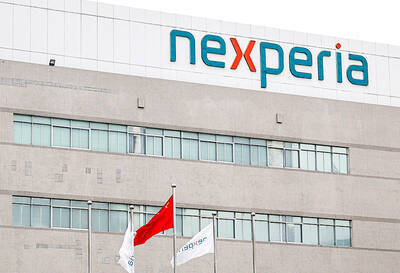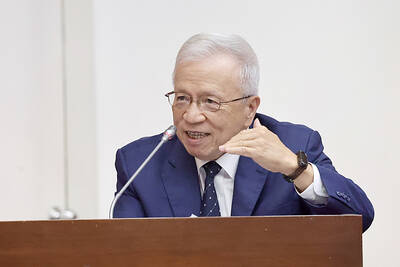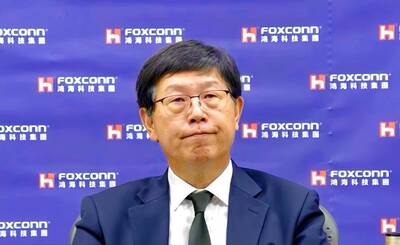LED chip supplier Formosa Epitaxy Inc (璨圓光電) said yesterday it planned to issue new common shares to raise funds from a Chinese investor via a private placement.
The Longtan Township (龍潭), Taoyuan County-based company said its board approved the management team’s proposal to sell as many as 120 million new shares at NT$19.6 per share to China’s Sanan Optoelectronics Co (三安光電).
Through the NT$2.35 billion (US$80.8 million) deal, Sanan Optoelectronics will acquire 19.9 percent of Formosa Epitaxy via its 100-percent owned Xiamen subsidiary and will become the firm’s largest institutional shareholder, ahead of Japan’s Mitsui & Co, which holds 15 percent.
The two sides will today formally sign a share subscription agreement, to take effect after gaining approval from their respective shareholders, Formosa Epitaxy said in a filing to the Taiwan Stock Exchange. The transaction is still subject to regulatory approval.
The firm is scheduled to hold a special shareholders’ meeting on Jan. 3 to seek approval for the sale.
The global LED industry grown rapidly in recent years as LEDs gain use in wide variety of applications, such as handset keypads, monitors and TV backlights. General lighting applications, such as street lighting, are also expected to support the growth of the LED industry. As an example, China has plans to install 2 million LED streetlights between 2010 and this year in 50 first-tier cities.
Formosa Epitaxy, the second largest LED chipmaker in Taiwan, said the new capital from Sanan Optoelectronics, which is primarily engaged in full-color high-brightness LED wafer and chip manufacturing, would help strengthen its financial position, expand its business scale and enhance its competitiveness, according to the filing.
The announcement came in the wake of market speculation that Taiwanese LED companies were in talks with their Chinese peers, including Sanan Optoelectronics, Hangzhou Silan Azure Co (杭州士蘭明芯科技) and BOE Technology Group Co (京東方), about potential partnerships, a move which analysts said would help re-energize Taiwan’s LED firms in view of the strong potential of the LED lighting market in China.
However, Taiwanese firms would face challenges from such cooperation in the long term, analysts said, because Chinese makers have been quickly upgrading their technology through recruiting engineers from Taiwan-based firms and expanding production capacity.
Moreover, Chinese firms are used to obtaining key technologies and production know-how without sharing profits with their Taiwanese peers, Fubon Securities Investment Services Co (富邦投顧) analyst Lewis Liu (劉立中) said in a Sept. 7 note.
Shares in Formosa Epitaxy moved up by the maximum 7 percent daily limit to close at NT$20.95 yesterday on the Taiwan Stock Exchange before the private placement announcement was made, outperforming the benchmark TAIEX, which was down 0.35 percent.
Trading of Sanan Optoelectronics shares, which closed at 13.1 yuan on Friday, was halted in Shanghai yesterday.
In the September quarter, Formosa Epitaxy reported a net loss of NT$33.67 million, or NT$0.07 per share, on revenue of NT$1.35 billion and a gross margin of 7.09 percent.
In the first three quarters of the year, its net loss was NT$168.68 million, or NT$0.35 per share, with revenue of NT$3.58 billion and gross margin of 3.63 percent, company data showed.

JITTERS: Nexperia has a 20 percent market share for chips powering simpler features such as window controls, and changing supply chains could take years European carmakers are looking into ways to scratch components made with parts from China, spooked by deepening geopolitical spats playing out through chipmaker Nexperia BV and Beijing’s export controls on rare earths. To protect operations from trade ructions, several automakers are pushing major suppliers to find permanent alternatives to Chinese semiconductors, people familiar with the matter said. The industry is considering broader changes to its supply chain to adapt to shifting geopolitics, Europe’s main suppliers lobby CLEPA head Matthias Zink said. “We had some indications already — questions like: ‘How can you supply me without this dependency on China?’” Zink, who also

At least US$50 million for the freedom of an Emirati sheikh: That is the king’s ransom paid two weeks ago to militants linked to al-Qaeda who are pushing to topple the Malian government and impose Islamic law. Alongside a crippling fuel blockade, the Group for the Support of Islam and Muslims (JNIM) has made kidnapping wealthy foreigners for a ransom a pillar of its strategy of “economic jihad.” Its goal: Oust the junta, which has struggled to contain Mali’s decade-long insurgency since taking power following back-to-back coups in 2020 and 2021, by scaring away investors and paralyzing the west African country’s economy.

BUST FEARS: While a KMT legislator asked if an AI bubble could affect Taiwan, the DGBAS minister said the sector appears on track to continue growing The local property market has cooled down moderately following a series of credit control measures designed to contain speculation, the central bank said yesterday, while remaining tight-lipped about potential rule relaxations. Lawmakers in a meeting of the legislature’s Finance Committee voiced concerns to central bank officials that the credit control measures have adversely affected the government’s tax income and small and medium-sized property developers, with limited positive effects. Housing prices have been climbing since 2016, even when the central bank imposed its first set of control measures in 2020, Chinese Nationalist Party (KMT) Legislator Lo Ting-wei (羅廷瑋) said. “Since the second half of

AI BOOST: Next year, the cloud and networking product business is expected to remain a key revenue pillar for the company, Hon Hai chairman Young Liu said Manufacturing giant Hon Hai Precision Industry Co (鴻海精密) yesterday posted its best third-quarter profit in the company’s history, backed by strong demand for artificial intelligence (AI) servers. Net profit expanded 17 percent annually to NT$57.67 billion (US$1.86 billion) from NT$44.36 billion, the company said. On a quarterly basis, net profit soared 30 percent from NT$44.36 billion, it said. Hon Hai, which is Apple Inc’s primary iPhone assembler and makes servers powered by Nvidia Corp’s AI accelerators, said earnings per share expanded to NT$4.15 from NT$3.55 a year earlier and NT$3.19 in the second quarter. Gross margin improved to 6.35 percent,